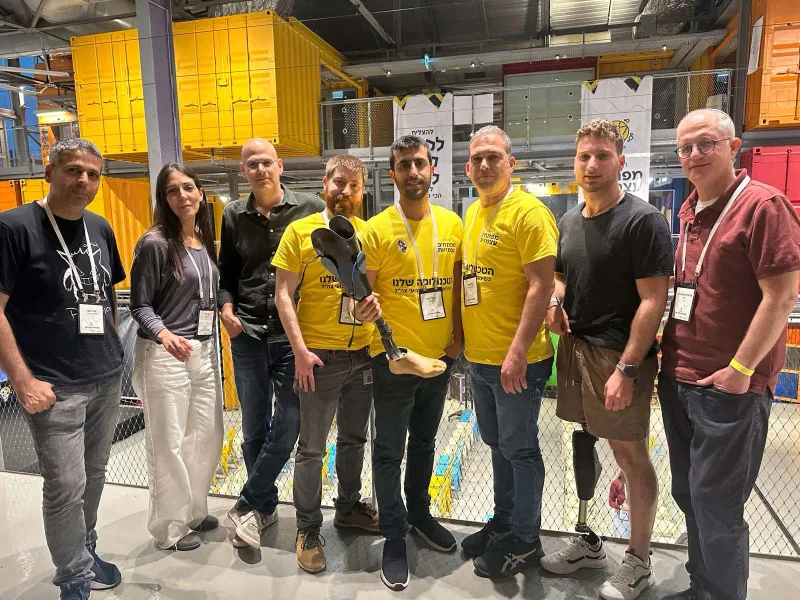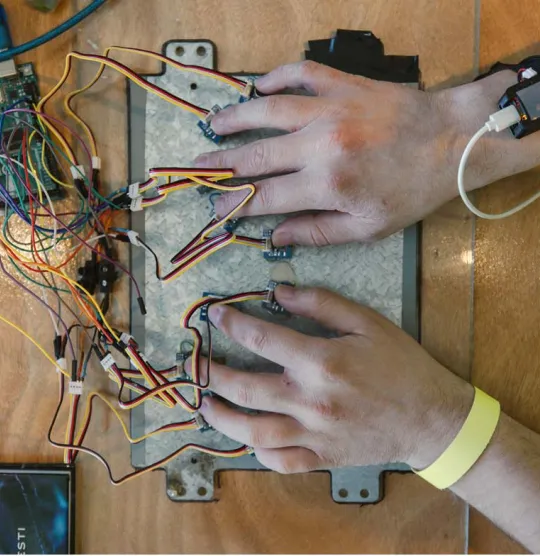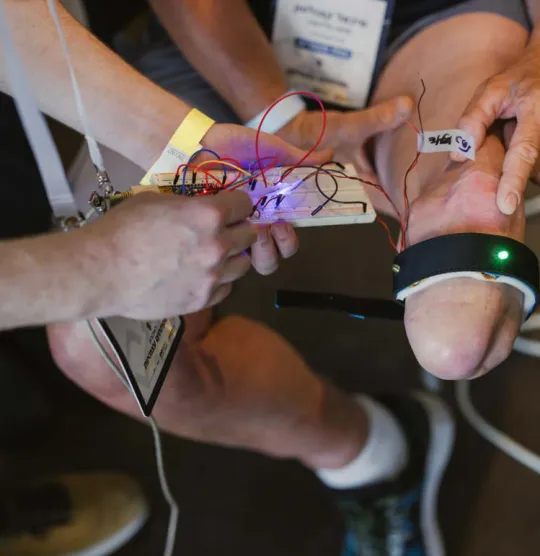
"We Wanted to Give Real Solutions to the Wounded"
Hosted by Elbit, this extraordinary hackathon brought professionals together to help create real-world solutions for soldiers injured in the " Sword of Iron” war — one idea at a time.
As dusk falls over the ancient port of Jaffa, dozens of Elbit Systems employees take their seats in the nearby “Container Hall”. They are not here for a routine meeting – but to innovate.
They’ve been divided into 15 teams, each gathered around tables strewn with half-empty coffee cups, focused on a single goal: to help those injured in the Iron Swords War.
This is no ordinary hackathon. Initiated by Elbit Systems in collaboration with Sheba Medical Center, the Restart organization, and other partners, it brings together innovation and impact in a uniquely calm and driven atmosphere. There’s no buzz or fanfare, just quiet determination and a shared sense of purpose.
Participants were tasked with three core challenges – each demanding advanced technological solutions beyond what currently exists: phantom limb pain in amputees, neuro-optic rehabilitation for head and vision trauma, and tools to support cognitive assessments for the wounded.
Motivation runs high. Later, three winning teams will be selected, and only their ideas will move forward into development and production. Some will work through the night; others plan to rest and return at dawn. But all of them know this is more than a hackathon – it’s a rare chance to create something that has the potential to change thousands of lives.
Pushing Boundaries – Together
The idea for the hackathon didn’t come out of nowhere. In the difficult days after October 7, Elbit looked for ways to contribute beyond its work on the battlefield – to create scalable solutions that serve not just one patient, but thousands.
"The "Swords of Iron" war took a heavy toll," says Dr. Shelly Gordon, EVP Chief Human Resources Officer at Elbit Systems. "Elbit lost seven employees. More than 20 immediate family members of employees were also killed, along with many others from our extended community. Supporting the injured and helping them return to independent, fulfilling lives became a top priority for us."
To identify the real needs, doctors, therapists, and wounded soldiers from Sheba Medical Center and Restart joined forces with Elbit. "For us, it’s a privilege to channel our knowledge, creativity, and innovation into something so meaningful," Dr. Gordon says. "This hackathon puts our values into action – creating impact, advancing innovation, and challenging our own limits."
Keys Instead of Pencils
Among the teams working with intense focus are Avraham, Rafael, and Arieh (full names withheld). They took on the challenge of aiding cognitive evaluators and developed a device that swaps outdated manual assessments for a precise, user-friendly interface – that happens to look like a piano.
"Cognitive evaluators need to assess a patient’s working memory to tailor a treatment plan," explains Avraham.
"Today, they use a pencil – tapping each finger lightly, and the patient has to recall the order. We turned that into an actual keyboard."
Specifically, a surface of keys, each vibrating on command. The patient experiences a sequence of vibrations and then reproduces it by pressing the keys. The system records the results, tracks response time, and generates insights – all with no manual input.
"We wanted a solution that feels friendly, not intimidating with wires and electrodes," Arieh adds. "It’s not a real piano, there’s no music, but it looks like one – and that creates a positive vibe, especially for kids."
Gaming the Pain
In a different room, a separate team tackled a familiar issue: phantom limb pain. One conventional therapy involves using a mirror to create the illusion of two intact limbs. Watching the reflection while moving the healthy limb can reduce pain in the missing one. But the method is repetitive and dull, and most patients give up.
"Our idea was simple – make therapy a game," says team leader Yaniv. "We used a semi-transparent mirror, projected an old video game – Space Invaders – behind it, and added a camera to track hand movements. When the patient moves their hand, they play. It’s fun, and we can track progress."
Yaniv recalls one trial when a patient with an amputation tried the setup and lit up with excitement. "That was powerful. We saw it worked – and realized this could improve life for many patients. One patient even suggested using the residual limb, not just the healthy one – that opened another path for us."
Scratching the Prosthetic
Next door, another team also tackled phantom pain, but from a different angle: smart prosthetics that restore sensation. "Today’s prosthetics are relatively not sophisticated," says Daniel, a team member.
"We want to make them an extension of the body – able to talk to the residual limb and relay precise feelings. If someone feels an itch in a missing leg, they should scratch the prosthetic – and the brain should feel relief."
Their team combined neuroscientists, electronics engineers, AI developers, and Rotem Inbar — a wounded soldier who lost a leg in battle and brought the patient’s perspective. Inbar, a Nahal Brigade fighter, was injured on October 7 at Sufa outpost and has been in long recovery. "During a session, I suddenly had phantom pain," he recalls. "I told them, and they immediately started brainstorming. Seeing them invest their whole heart – it’s moving. We can truly help people like me."
Among the team is Dr. Ariel, a neuroscientist and Elbit advisor. Their device maps the missing limb by stimulating contact points on the stump. "If someone feels an itch in a toe that’s no longer there, we stimulate a specific point on the stump to mimic that toe. Scratching that point feels like scratching the toe."
"When we first developed the idea, our goal was to give control back to the patient," says Tal, another team member. "No one wants to feel helpless. When you scratch and actually feel it – you’re in control. That’s what this is about."
Shani, a neuroscientist and team member, adds: "What makes our product unique is that it stems from real understanding – of what’s happening in the body and what’s needed. That makes it more accurate and better tailored to the people who’ll use it."
A Vision Worth Fighting For
In another corner of the Hall, Orly is working on the third challenge – neuro-optic rehabilitation. "Some injuries affect both the brain and vision, and we want to help patients train and improve visual function," she explains. "Our system builds on Elbit’s world – wide screens like military simulators – but used therapeutically."
The system features exercises targeting specific visual functions: expanding peripheral vision, eye tracking, and binocular coordination. Patients follow the exercises while the system measures reaction time and accuracy – and tracks progress over time. "Our soldiers are at the heart of Israeli society," says Orly. "If we can help them recover, it’s our duty."
"There’s No One Like You"
As night falls, Dr. Gordon walks through the rooms, filled with pride. "This is the spirit of our people," she says. "Anyone who saw the passion, commitment, and love over these past two days – and in the weeks leading up – knows what I mean. It’s heartwarming. I tell everyone here – there’s no one like you. You’re making the world better."




